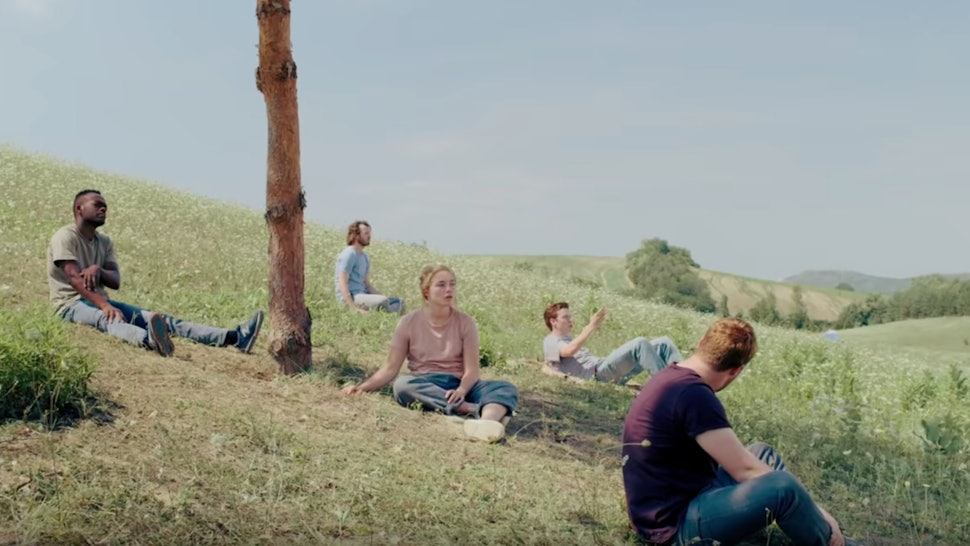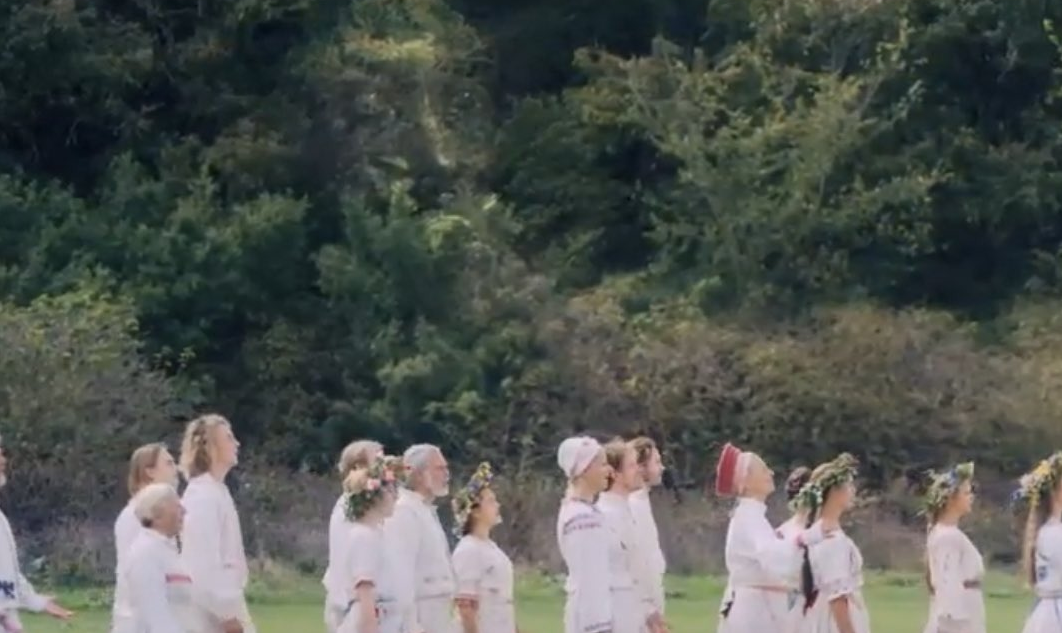How Midsommar Lures Audiences into a False Sense of Security with Lighting and Color
Warning: spoilers
Other warning: this movie is really graphic
Articles:
'Midsommar:' How Ari Aster and Pawel Pogorzelski Created a Technicolor Fairy Tale Nightmare
The Architecture of Horror: Space, Light, and Atmosphere in Ari Aster’s Hereditary and Midsommar
Midsommar and the blinding terror of ‘daylight horror’
The Unsettling Glow of Daylight: DP Pawel Pogorzelski on Shooting the Folk Horror of Midsommar
Midsommar and the Terrifying Complex of Daylight
Midsommar: Horror in the Light of Day
These links are just a few of the articles I found when googling "lighting in Midsommar." Other than the last one, where the analysis of the plot, I feel, is just not correct, all of them agree on one idea: that horror is significantly more horrifying when it's set in the daylight. It's been a little while since I watched this movie, but the feelings of discomfort and unsettledness have stayed with me. I did not know going into this movie quite what it was about, so you can imagine my surprise when I got to the end. This was unlike any movie I've ever seen, and lighting and coloring are the reason why.
If this movie had been set in the dark for a majority of the scenes, I would've mentally prepared myself to watch a scary movie. Most of the scenes take place in the middle of the day, when the sun is at its brightest, and that invokes a more eerie feeling as we see what unfolds. You can read the plot summary here.
The first scene in the movie is the darkest (visually) in the whole movie. We see Dani's parents' and sister's bodies in the dark house, and then the scene changes. The scene is still dark, but is now on the path to getting lighter. When Dani, Christian, and his friends arrive to Sweden, the sunshine is bright and jarring. The people they meet act strange and unnatural, but that can easily be dismissed as a cultural thing. Because the scene is bright, the audience feels a sense of safety, because nothing bad happens in the light, right?
A lot of weird stuff happens, and the lighting doesn't help the situation. The effects of the drugs they take establishes the fact that we can't trust what we see. The trees move, Dani sees her dead parents in the crowd, and the dying image of her sister even appears in the trees (Fig. 3). As all this cult-y stuff happens, we only ever see it in the day. We are not able to protect ourselves by hiding in the shadows; the horror is out in the open for all to see.
I won't include pictures here, but some of the scariest scenes in the movie are when we are able to see death in broad daylight as if they're nothing out of the ordinary. The two elders who commit the suicide ritual do it during the day. We see them land on the rocks below, and it is awful. Josh's hand sticks up from the ground in the middle of a garden, but it's barely noticeable among the plants (and let's not forget that they skinned his face off first). Simon's body is hung in the cult's chicken coop in a "blood eagle" position (I'm not going to include a picture because it's honestly disturbing). All of these are shot in daylight, and made me do a double-take when I saw them. I'm not a big fan of scary movies, and it was silly of me to watch Midsommar thinking it wouldn't be scary because of all the ads of Florence Pugh wearing flowers. All of this twistedness happens around her, and the bright, pretty colors mask it almost. I kept forgetting that I was watching a horror movie because of how idyllic and beautiful the commune was.
Look at Fig. 5; the flowers and bright daylight coupled with Pugh's smile would, on their own, make this seem like a happy image. However, when you realize what she's looking at, the reality is much, much worse. She has just been crowned the May Queen, and has just selected Christian to be the final sacrifice for the midsummer ritual. He is paralyzed, stuffed into a bear carcass, and burned alive in a bright yellow temple surrounded by the other sacrifices (some of whom were his friends). Everything about this movie is, to put it bluntly, crazy.
Whether it's the hallucinogenic drugs manipulating the visitors' view or the Hårga people just being creepy white people, it seems like the audience can't trust anyone. That's how I felt when I watched this movie. I am almost certain that this is because of the daylight and the white costumes that everyone wears. As I mentioned in my paper. lightness is always the trustworthy, "good" symbol, and darkness is the "evil" one. In Midsommar, lightness is in everything: colorful flowers on the costumes and the maypole, white clothes and tablecloths, and even the green pasture of the Hårga. The sacrificial temple is bright yellow!
I also think the light colors lure us into a false sense of security because Dani, Christian, Josh, and Mark all wear dark clothes from our (the American audience's) world. We are accustomed to the usual darkness of our everyday lives. When they arrive to Hårga, it looks like a utopia. Everyone is a part of one big community where everyone wears white and sings songs and eats together in a really creepy fashion, and everything is harmonious. That's, at least, how Dani perceives it. That's why the reality comes as such a huge shock, because literally nothing it as it seems. This movie is a perfect case study on how light can make scary movies scarier, and how easily audiences are lured into a false sense of security because of it.
Midsommar and the blinding terror of ‘daylight horror’
The Unsettling Glow of Daylight: DP Pawel Pogorzelski on Shooting the Folk Horror of Midsommar
Midsommar and the Terrifying Complex of Daylight
Midsommar: Horror in the Light of Day
These links are just a few of the articles I found when googling "lighting in Midsommar." Other than the last one, where the analysis of the plot, I feel, is just not correct, all of them agree on one idea: that horror is significantly more horrifying when it's set in the daylight. It's been a little while since I watched this movie, but the feelings of discomfort and unsettledness have stayed with me. I did not know going into this movie quite what it was about, so you can imagine my surprise when I got to the end. This was unlike any movie I've ever seen, and lighting and coloring are the reason why.
If this movie had been set in the dark for a majority of the scenes, I would've mentally prepared myself to watch a scary movie. Most of the scenes take place in the middle of the day, when the sun is at its brightest, and that invokes a more eerie feeling as we see what unfolds. You can read the plot summary here.
 |
| Figure 1 - Opening scene of the movie |
 |
| Figure 2 - After they arrive |
 |
| Figure 3 - Dani's sister in the pasture |
 |
| Figure 4 - the visitors at the meal table (with the temple behind them) |
| Figure 5 - Closing shot of Midsommar |
Whether it's the hallucinogenic drugs manipulating the visitors' view or the Hårga people just being creepy white people, it seems like the audience can't trust anyone. That's how I felt when I watched this movie. I am almost certain that this is because of the daylight and the white costumes that everyone wears. As I mentioned in my paper. lightness is always the trustworthy, "good" symbol, and darkness is the "evil" one. In Midsommar, lightness is in everything: colorful flowers on the costumes and the maypole, white clothes and tablecloths, and even the green pasture of the Hårga. The sacrificial temple is bright yellow!
I also think the light colors lure us into a false sense of security because Dani, Christian, Josh, and Mark all wear dark clothes from our (the American audience's) world. We are accustomed to the usual darkness of our everyday lives. When they arrive to Hårga, it looks like a utopia. Everyone is a part of one big community where everyone wears white and sings songs and eats together in a really creepy fashion, and everything is harmonious. That's, at least, how Dani perceives it. That's why the reality comes as such a huge shock, because literally nothing it as it seems. This movie is a perfect case study on how light can make scary movies scarier, and how easily audiences are lured into a false sense of security because of it.
Comments
Post a Comment